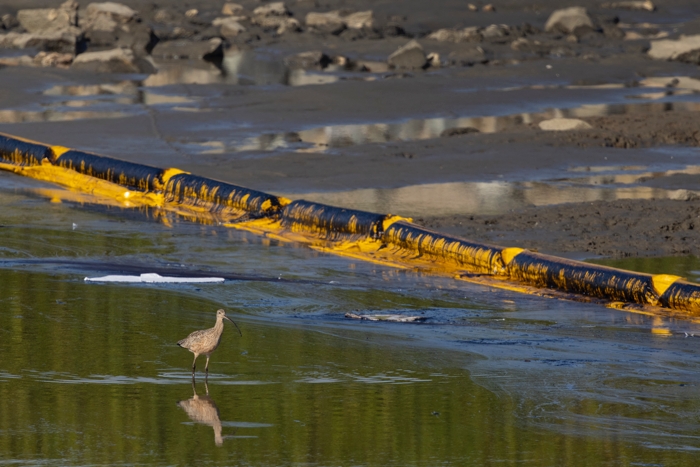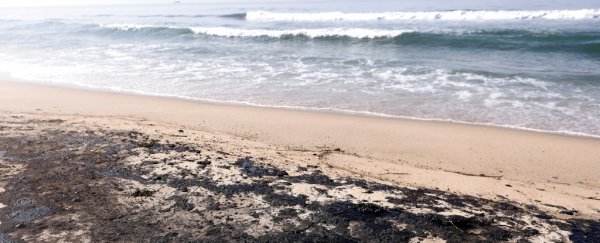A huge oil spill is killing wildlife and threatening California's beaches on Monday, in what officials said amounted to an "environmental catastrophe".
Birds and fish had begun washing up on the shore as a 126,000-gallon slick of crude oil choked waters south of Los Angeles, after spewing from a pipeline connected to an offshore rig.
A 15-mile (24-kilometer) stretch of coastline was closed to the public and fishing was halted as crews scrambled to clean up one of California's biggest spills in decades.
Beaches could remain closed for weeks or even months, Huntingdon Beach Mayor Kim Carr warned.
"Our wetlands are being degraded and portions of our coastline are completely covered in oil," she said.
 A long-billed curlew in oily water at Newport Beach, 3 October 2021. (David McNew/AFP)
A long-billed curlew in oily water at Newport Beach, 3 October 2021. (David McNew/AFP)
The US Coast Guard, which is coordinating the response, said oil amounting to less than three percent of the spill plume – estimated to be 5.8 nautical miles long – had been recovered, and that more than a mile of oil containment booms had been deployed.
"Unfortunately, we are starting to see oil covered fish and birds washing up along our coastline," including in protected wetlands, the City of Huntington Beach said Sunday.
Amplify Energy, the company that operates the pipeline, said Monday that "as a precautionary measure, all of the company's production and pipeline operations at the Beta Field have been shut down".
CEO Martyn Willsher pledged the firm will do "whatever needs to be done" to take care of the spill, and said the company had significant insurance to cope with associated costs.
Willsher said a remotely operated vehicle had located the probable source of the leak, and divers would be visiting the spot on Monday afternoon.
Just devastating
Officials have warned people not to touch or try to save any wildlife they find, but to instead call local authorities to alert them to animals affected by the oil.
"This is just devastating for our marine life, our habitat, our economics, our entire community," Orange County Supervisor Katrina Foley said Sunday.
"Our natural habitat we've spent decades building up and creating is just damaged in a day."
The spill originated near the Elly platform, which was built in 1980 and is one of 23 oil and gas drilling platforms in federal waters off California, the Los Angeles Times reported.
The disaster has already reignited a debate about the presence of oil rigs and pipelines near the coast of Southern California.
"The oil spill… is as tragic as it was preventable," said Alan Lowenthal, a Democrat who represents the area in the US Congress.
"This environmental catastrophe highlights the simple fact that where you drill, you spill.
"This will be devastating not only to our marine wildlife and ecosystem, but also to the livelihoods of our coastal communities which are built around fishing, tourism, and recreation.
"As long as these platforms and pipelines remain, our coastal communities remain under threat from potential disasters like we are now seeing."
Oil spills have scarred California for decades; pictures of dead, oil-covered dolphins and tar-stained beaches off Santa Barbara in 1969 spurred widespread revulsion.
California has not granted any permits to drill for oil since then.
But the state's jurisdiction extends only 3 miles offshore, and federally sanctioned oil and gas platforms dot the area's seascape, many of them easily visible from the shore.
Environmentalists have repeatedly called attention to the age of some of the facilities, which they say are rusty and poorly maintained, and the risks they pose.
The nature of the current oil spill has not been determined, but leaks were detected in 1999 on the pipeline linking two platforms in the Beta field, which was then jointly operated by Mobil and Shell, according to the Los Angeles Times.
"This is why the US needs to end coastal oil drilling," the Times wrote in an editorial.
